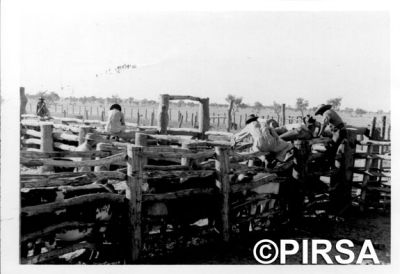Legislation
John Love in his document “Determined to Improve the Land: A History of the Department of Agriculture” (Love John, Determined to improve the land: a history of the Department of Agriculture, The History of Agriculture in SA website (), (1987)) details the relevant Parliamentary Acts, research and extension carried out by the government. It is interesting to note in all references examined how rarely beef cattle are mentioned, from which we can suppose little or no government research or extension was carried out until the 1940s. By contrast regulation has always been important.
In December 1840 An Act to Regulate the Slaughtering and Prevention of Stealing of Cattle was passed.(Love John, Determined to improve the land: a history of the Department of Agriculture, The History of Agriculture in SA website (), (1987)). It provided for the licensing of slaughterhouses, appointment of ‘Inspectors of slaughterhouses and of brands’, the creation of a Cattle Registry Office (to register brands) and the inspection of butchers’ shambles (slaughterhouse) to ensure cleanliness. The Cattle Registry Office was established in January 1841 but closed six months later because the Colony was in a severe financial depression. The public health function of the Act continued to be enforced but the brands function was neglected. Both functions were passed over to district councils by the Act of 1852 which provided for their formation. However, with no central register of brands, pound keepers were at a disadvantage in trying to identify stray stock, while preventing duplication of brands was virtually impossible. This was followed by the Stock and Brands Act (1861). This situation continued until 1878, in spite of occasional attempts by owners of stock to get a new Brands Act passed. However inauspicious, this was the beginning of one part of the Department of Agriculture. (Love John, Determined to improve the land: a history of the Department of Agriculture, The History of Agriculture in SA website (), (1987)).

Photo No.: 103744 Title: Drafting cattle. Date: 25 Oct 1967
The Cattle Importation Act, 1861 applying to horses, horned cattle and sheep, was in part an attempt to prevent contagious bovine pleuro-pneumonia from being introduced from the other colonies. In this respect its failure was inevitable because so much overland transport was by bullock wagon and the insidious nature of the disease allowed an infected but apparently healthy animal to pass unnoticed. Vaccination was practised as early as 1862 but not widely adopted by stockowners. The Stock Diseases Act, 1888 gave stock inspectors greater powers, including quarantine, compulsory vaccination and the destruction of infected stock. Nevertheless, gaining the upper hand over this disease was a very long and gradual process and it was not until 1974 that Australia was declared free of it. To prevent the introduction of stock diseases from overseas, a cattle quarantine station was built on Torrens Island in 1879.
Prolonged attempts to get a new Brands Act through Parliament succeeded in 1878. Parts of the 1840 Act, which had become virtually inoperative, were repealed, and provisions made for branding horses, cattle and sheep. Branding was voluntary but the use of unregistered brands was prohibited. The Chief Inspector of Sheep became the Chief Inspector and Registrar of Brands. Incidental to the main purpose of the Act, owners of travelling stock were required to provide the drovers with waybills specifying the numbers being moved. This was to prevent them from surreptitiously adding to their mobs while crossing other people’s leases. The Act was repealed in the following year and replaced by one that was similar but better drafted. These procedures prepared the way for the formation of the Stock and Brands Department, which was first listed under that name in 1881. (Love John, Determined to improve the land: a history of the Department of Agriculture, The History of Agriculture in SA website, (1987)). It was not until 1945 that the Stock and Brands Department became part of the Department of Agriculture.
Abattoirs, brands, diseases, compensation, quarantine meat hygiene issues have all periodically had regulation occur on the statutes to meet a perceived threat to the beef industry, the State or the community. Many have been periodically revised, updated or in a few cases discarded. A list of all Acts relative to agriculture
